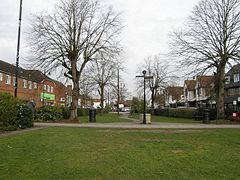Thatcham
| Thatcham | |
|---|---|
 The Broadway, Thatcham |
|
| Thatcham shown within Berkshire | |
| Area | 21.76 km2 (8.40 sq mi) |
| Population | 25,267 (2011 census) |
| • Density | 1,161/km2 (3,010/sq mi) |
| OS grid reference | SU5167 |
| Civil parish |
|
| Unitary authority | |
| Ceremonial county | |
| Region | |
| Country | England |
| Sovereign state | United Kingdom |
| Post town | THATCHAM |
| Postcode district | RG18 and RG19 |
| Dialling code | 01635 |
| Police | Thames Valley |
| Fire | Royal Berkshire |
| Ambulance | South Central |
| EU Parliament | South East England |
| UK Parliament | |
Thatcham is a town in the historic county of Berkshire, England, centred 3 miles (5 km) east of Newbury, 14 miles (24 km) west of Reading and 54 miles (87 km) west of London. Its population grew rapidly in the second half of the 20th century: from 5,000 in 1951 and 7,500 in 1961 to 22,824 in 2001.
Thatcham straddles the River Kennet, the Kennet and Avon Canal, the A4 and the course of a Roman road. It is served by Thatcham railway station on the line between Reading and Newbury. Local employment is chiefly in light industrial premises, sales and distribution, retail and public sectors; see also West Berkshire, its district.
The area has evidence of occupation dating from prehistoric times and is listed in the Guinness Book of Records as the strongest claimant to being the oldest continuously inhabited place in Britain. The well-preserved remains of a Mesolithic settlements dating from 8400 to 7700 BC have been found in its vicinity. Evidence also exists of Bronze and Iron Age settlements and of a Roman town.
The name may have been derived from that of a Saxon chief called Tace (or perhaps Tac or Tec), who established a village in around AD 500. The settlement was known as Taceham - ham meaning village in Saxon. It is also possible that the name may have come from the Saxon þæc or thaec (thatch). Wherever it came from, the name Taceham persisted until after the Norman Conquest in 1066 before going through several minor changes until the current form was adopted in the 16th century.
...
Wikipedia

